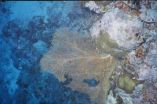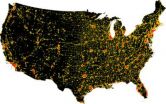(Press-News.org) COLUMBUS, Ohio – Researchers looking at corals in the western tropical Pacific Ocean have found records linking a profound shift in the depth of the division between warm surface water and colder, deeper water traceable to recent global warming.
The finding is the first real evidence supporting what climate modelers have been predicting as the effects of global climate change on the subsurface ocean circulation.
The report by researchers from Ohio State University and the University of Toronto was published in the latest online edition of the journal Geophysical Research Letters.
"We're trying to find a way to understand how the warm water in the tropical Pacific has changed in the last century, but more importantly during the last several decades," said Branwen Williams, who conducted this research while a doctoral student at Ohio State. Williams is now a postdoctoral fellow at the University of Toronto.
"The Pacific is really important since it serves as a strong driver and changes in this ocean can have a very strong impact on global climate and oceanography."
What plagues modelers and researchers alike is the limited amount of information available about the ocean when studying climate change. Satellite data and physical measurements are mainly restricted to the ocean's surface waters. What happens deeper in the waters is often an unknown.
Williams and Andrea Grottoli, an associate professor of earth sciences at Ohio State and Williams' former advisor, turned to a prolific form of soft coral, the Gorgonians, growing on a reef off the island nation of Palau.
"These corals 'sway' with the current underwater," Grottoli explained, "like trees in the wind. Since they aren't restricted to shallow and warmer surface waters like other tropical corals, they provide an opportunity to reconstruct a picture of subsurface ocean circulation in a region."
Specifically, the researchers were interested in how the boundary layer between the warmer, shallow water and the colder deeper water -- the thermocline -- has changed. But directly measuring that over time and across a broad area is impossible.
Instead, they used the soft corals as a substitute, a proxy, for determining how the thermocline rose and fell over time. Working with samples taken from corals at five meters (16.4 feet), 85 meters (279 feet) and 105 meters (345 feet), they analyzed the chemical structure of the coral skeleton that had built up over time.
Slices cut through the base "trunk" of the coral revealed concentric circles resembling tree rings which showed the growth of the "trunk" over time. By analyzing material from the rings from the outer surface inward to the center, they assembled a growth record covering the last century or so.
They were looking for the ratio between two isotopes of nitrogen in the material as a clue to how the thermocline rose or fell over time. Warmer waters above the thermocline contained lower levels of nutrients resulting in organic matter with a high ratio of nitrogen-15 to nitrogen-14 isotopes. Waters below the thermocline held higher levels of nutrients resulting in organic matter with a low ratio of nitrogen-15 to nitrogen-14 isotopes.
As the polyps in the coral consumed the organic matter over the years, the nitrogen isotopes were chemically recorded in the coral. By comparing the nitrogen-15 to nitrogen-14 ratios in samples from the three depths, they could draw a picture of how the thermocline moved.
"Over several decades, specifically since the mid- to late-1970s, the records show that the mean depth of the thermocline has been getting shallower," Williams said.
The researchers did a similar analysis of the ratio of two carbon isotopes in the coral samples as well. "I think it's fair to say that the carbon isotope record supports this interpretation," Grottoli said. "It's another piece of evidence backing our conclusions."
The researchers were also looking at how the coral record meshed with the Pacific Decadal Oscillation (PDO), a long-lived pattern of climate variability similar to the El Nino phenomenon. While El Nino changes over a period of years, the PDO changes over decades.
"Climate modelers looking at how the Pacific might respond to global warming have predicted that the atmospheric patterns in the tropical Pacific would weaken, and if that happened, you would expect the thermocline to get shallower in the western tropical Pacific," Williams said.
"Our data are some of the first proxy data to support what the modelers have been predicting."
Grottoli said that the thermocline shift in the 1970s is important because it coincides with changes in the PDO from a negative phase to a positive phase.
"We think the thermocline rose when the PDO shifted," she said, "that it was a cumulative effect of both the natural variability of the PDO plus the warming global temperatures." Grottoli said that their coral record covered two other known times when the PDO shifted – in the 1920s and 1940s when average ocean termperatures were a bit lower than today – but neither caused a rise in the thermocline, based on their study.
The researchers want to repeat their study using coral samples from other locations, moving eastward across the Pacific, to test their findings that the thermocline shift wasn't a regional phenomenon, that it is occurring all across the ocean basin, Williams said.
INFORMATION:
Along with Williams and Grottoli, Patrick Colin, director of the Coral Reef Research Foundation, assisted in the project. Support for the research came from the National Science Foundation, the PADI Foundation, the Andrew Mellon Foundation and the National Ocean Sciences Accelerator Mass Spectrometry Facility at the Woods Hole Oceanographic Institution.
Contact: Branwen Williams, (905) 828-5419; branwen.williams@utoronto.ca or Andrea Grottoli, (614) 292-5782; grottoli.1@osu.edu
Written by Earle Holland, (614) 292-8384; holland.8@osu.edu.
Coral records show ocean thermocline rise with global warming
2010-10-13
ELSE PRESS RELEASES FROM THIS DATE:
sonRAIL -- computer model to calculate noise levels along the Swiss rail network
2010-10-13
Goods trains move at night because during daytime the Swiss rail system is used to full capacity by passenger traffic. Unfortunately, it is goods trains which make the most noise – and they operate at exactly the time when most people want to sleep. If the policy of shifting goods transport from the roads to the rail network is to succeed, then goods trains must be made significantly quieter.
The Swiss Federal Office for the Environment (FOEN) therefore tasked a team of scientists, headed by Kurt Eggenschwiler of Empa's Acoustics and Noise Control Laboratory, with the ...
Canadian leads publishing of first results from Large Hadron Collider
2010-10-13
Researchers used Einstein's famous E=mc2 equation and the Large Hadron Collider to recreate a miniature version of the event at the origins of our Universe, and the first findings from their work were published in the journal Physical Review Letters. Dr. Andreas Warburton of McGill's Department of Physics made leading contributions to the analysis of data from the experiment, known as "ATLAS," meaning the findings have a special significance for Canadian science.
Warburton and 3171 colleagues from around the world are using the data collected from the recreation in an ...
Population change: Another influence on climate change
2010-10-13
Changes in the human population, including aging and urbanization, could significantly affect global emissions of carbon dioxide over the next 40 years, according to research results published this week.
The research, results of which appear in a paper in the journal Proceedings of the National Academy of Sciences (PNAS), was conducted by scientists at the National Center for Atmospheric Research (NCAR), the International Institute for Applied Systems Analysis (IIASA) and the National Oceanographic and Atmospheric Administration (NOAA).
It was funded by the National ...
K-State advances field of ecological genomics with research, symposium
2010-10-13
MANHATTAN, KAN. -- A Kansas State University professor's research and the upcoming Ecological Genomics Symposium continue to make the university a leader in the emerging field of ecological genomics.
Ecological genomics is an integrated field that focuses on how organisms, ecosystems and communities respond to environmental change. It uses genomic technologies, such as gene sequencing and expression analysis, on a wider scale to ask and research ecological questions, said Michael Herman, associate professor of biology.
"We're working hard to advance this field," Herman ...
Pediatric hospitalizations for ATV-related injuries more than double
2010-10-13
All-Terrain Vehicles (ATVs) are associated with a significant and increasing number of hospitalizations for children in the U.S., according to a new report by the Center for Injury Research and Policy at the Johns Hopkins Bloomberg School of Public Health. Over a nine- year period (1997-2006) hospitalizations for ATV injuries increased 150 percent among youth younger than 18 years, with important demographic variations. Rates increased the most dramatically in the South and Midwest, and among teens ages 15 to 17. While males between 15 to 17 have the highest rate of ATV ...
U of M researchers find children's health insurance coverage varies widely
2010-10-13
MINNEAPOLIS/ST.PAUL (Oct. 12, 2010) – Children's health insurance coverage still varies significantly at both the state and national levels, according to researchers at the University of Minnesota School of Public Health (SPH). In particular, researchers found gaps in coverage that vary across states by age, race/ethnicity and income.
Even states with relatively low rates of uninsured children have gaps in coverage for some groups of children, according to researchers. Conversely, some states demonstrating high rates of uninsurance have relatively low gaps or disparity ...
1 step closer to a drug treatment for cystic fibrosis, MU professor says
2010-10-13
COLUMBIA, Mo. – A University of Missouri researcher believes his latest work moves scientists closer to a cure for cystic fibrosis, one of the world's most common fatal genetic diseases.
The Journal of Biological Chemistry has published findings by Tzyh-Chang Hwang, a professor in the School of Medicine's Department of Medical Pharmacology and Physiology and the Dalton Cardiovascular Research Center. The publication has been recognized as the "paper of the week" for the journal, meaning Hwang's work is considered to be in the top 1 percent of papers reviewed annually ...
Gambling on bacteria
2010-10-13
When it comes to gambling, many people rely on game theory, a branch of applied mathematics that attempts to measure the choices of others to inform their own decisions. It's used in economics, politics, medicine -- and, of course, Las Vegas. But recent findings from a Tel Aviv University researcher suggest that we may put ourselves on the winning side if we look to bacteria instead.
According to Prof. Eshel Ben-Jacob of Tel Aviv University's School of Physics and Astronomy, current game theory can't account for bacteria's natural decision-making abilities -- it's just ...
Medical researchers break down costs to care for heart failure patients at the end of life
2010-10-13
As the population ages, health care epidemiologist Padma Kaul and cardiologist Paul Armstrong, researchers in the Faculty of Medicine & Dentistry at the University of Alberta, want health-care professionals to talk to their patients about their options on places to die, whether it be at home, in hospital or a palliative care facility like hospice.
The researchers found, in their recent study, that the majority of heart failure patients pass away in an acute care hospital and the cost is more than double for those who died elsewhere.
This is the first study to examine ...
Why it's hard to crash the electric grid
2010-10-13
Last March, the U.S. Congress heard testimony about a scientific study in the journal Safety Science. A military analyst worried that the paper presented a model of how an attack on a small, unimportant part of the U.S. power grid might, like dominoes, bring the whole grid down.
Members of Congress were, of course, concerned. Then, a similar paper came out in the journal Nature the next month that presented a model of how a cascade of failing interconnected networks led to a blackout that covered Italy in 2003.
These two papers are part of a growing reliance on a particular ...


